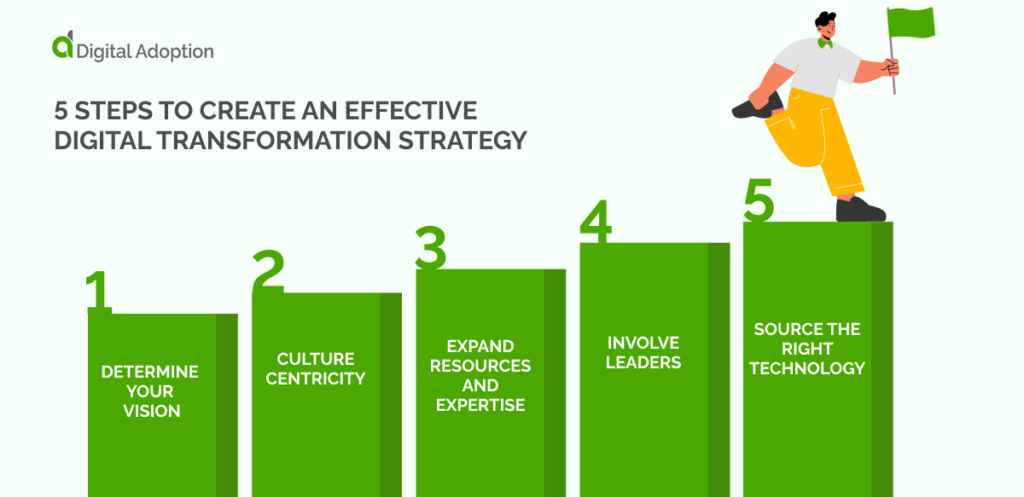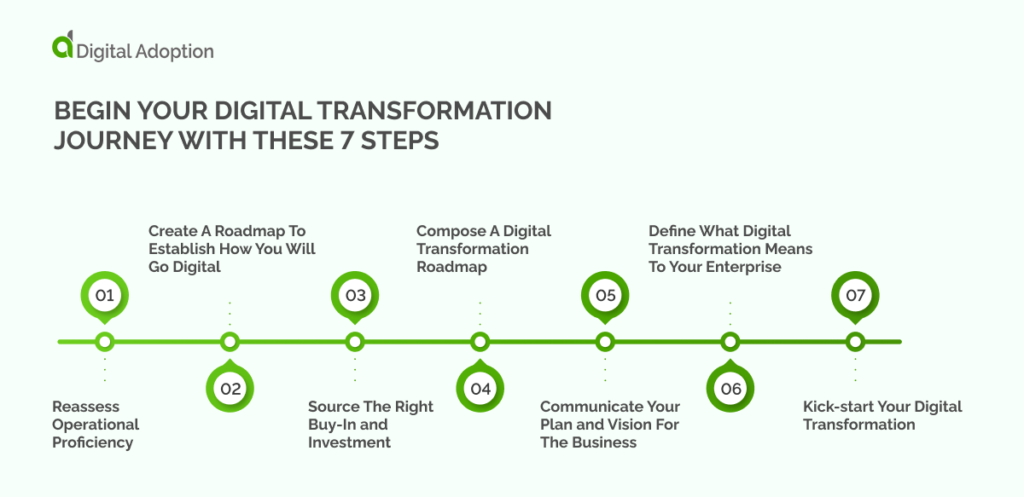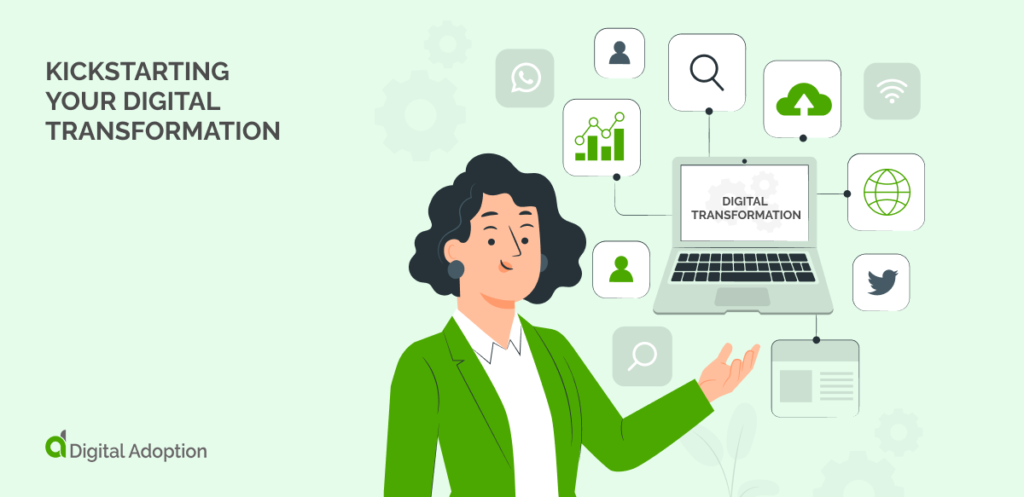Successful digital transformation initiatives need a watertight strategy, reevaluation of operational excellence, a clear roadmap, buy-in, and investment. In addition, you must also communicate your business goals & vision and define what digitization means to your business.
Without a good strategy, your organization could be in the middle of a painful transformation whose scope grows daily.
So we evaluated companies with successful digital transformations and devised the five steps to create an effective digital adoption strategy. In addition, we compiled the seven strategies to get your organization started in a digital adoption journey.
Here, take a look!
5 Steps To Create An Effective Digital Transformation Strategy

Digital technology brings excellent opportunities and enormous challenges. Check out five steps that will make your digital transformation efforts productive below.
1. Determine Your Vision
Before jumping into a digital strategy, consider what your business wants to accomplish.
The following are possible questions to ponder during this procedure.
- Where are we, and where do we want to go? A digital transformation must align with the overall business goals.
- What will a successful digital transformation look like? Paint a picture that everyone in the organization will understand.
- What are the company’s strategic blind spots?
- What obstacles do your staff face in their daily company operations?
- How can we use new technologies to help our staff succeed in their jobs?
You must also consider the implications of digital transformation for your customers. It should be customer-centric. In fact, McKinsey found that B2B and B2C companies that adopt broad digital transformations in customer experience processes reduced expenses by 10% to 20% and increased customer satisfaction scores. They also report a 10% to 15% revenue growth.
2. Culture Centricity
Adopting a new way of doing things in established organizations is uncomfortable for most. And the organizational culture has a 20% impact on how organizations utilize technology. That’s why the best digital transformation results come from firms prioritizing cultural shifts toward a digital-first mindset.
To facilitate cultural change, ensure the changes are consistent with your business goals. And the digital transformation leaders should be vocal about the organization’s values and the impact/need for the transformation. Then let everyone knows the business strategy before they embark on digital transformation projects.
To create a culture-centric digital transformation, consider these tips:
- Get everyone who will touch (or will be affected by) the new system on board.
- The next step is getting leaders on board to demonstrate, promote, and model the new working methods to ensure the program is noticed.
- Finally, have innovation lunches where staff can brainstorm new processes and tools for the system, like collaborative and customer awareness tools, to make the adjustments easier.
You could try strategies like gamification and guided learning programs to speed up understanding and adoption of technology. That worked for Salesforce. The company’s transformation began to take hold as people adopted new habits and technology. Furthermore, customer focus and responsiveness improved, as did overall happiness with the work environment, making it a win-win situation for all parties involved.
3. Expand Resources and Expertise
In every digital transformation’s success, technology investments play a critical role. Integrating the cloud and creating cross-functional teams that include IT, digital marketing, customer service, and sales will help your business be in the driver’s seat of implementing new ways of doing things faster than ever before.
In addition to expertise from within your organization, you may consider external experts. Whether in the cloud or via remote video meetings, hybrid teams foster innovation and break down silos.
You must keep costs down regarding technologies and the enablement of staff who will work with the new business processes. It often includes restructuring into smaller groups to work more fluidly as a team or upskilling your team.
For example, during Levi Strauss & Co.’s digital transformation, they launched an 8-week paid Machine Learning Bootcamp to upskill their employees in coding, statistics, and more. Because the organization believed in their employees’ power to drive change, they gave the staff the ability to leverage machine learning and AI instead of hiring external tech experts.
4. Involve Leaders
A McKinsey Global Survey found that exemplary leadership is critical in digital transformation – over 70% of respondents said that their firm’s top management teams changed during the shift to accommodate digital technology experts.
So digital transformation success requires support from the top management. So C-Suite executives and those with transformation-specific duties should be involved. And if needed, hire external experts (e.g., digital transformation consultants).
The same Mckinsey survey found that less than a third of organizations involve a Chief Digital Officer in their transformation. But those that engaged such a leader were 1.6 times more likely to have a successful digital transformation than others.
Consider how Dominos created an immersive digital experience for their customers, steadily increasing their sales for over a decade. Their AnyWare technology made a multi-experience for their customers so they could order pizza from any device. But one key reason the transformation was successful was getting the top leader’s buy-in. That’s according to Domino’s SVP of eCommerce Development and Emerging Technologies, Kelly Garcia, and analysts at Gartner.
Once the Board was on-board, they got the funding for the technology investment. And Kelly noted that when the top leaders aligned as partners, they set an excellent example for the rest of the company.
5. Source the Right Technology
While digital transformation is not only about technology (it’s equally about the people), your team needs the right technology to achieve the digital transformation vision and business goals. In most cases, digital innovations like Big Data, Robotic Process Automation, Cloud computing, artificial intelligence, and sensor technology drive transformation. And the most important thing is to choose a tech that aligns with the overall business strategy, not vice versa (force-fitting a tool).
More often than not, digital transformations cut across departments. Like when changing an ERP system, you need to consider all the other applications that the system feeds data into o/out of. Your team will need to analyze each department participating in the transformation.
And besides having the necessary technology to change business processes, organizations need digital adoption solutions to help employees learn how to use the technology to its total capacity.
Many organizations try to transform their digital business by improving efficiency, end-user experience, and quality control through technology implementation.
Measure & Adjust

A successful transformation is defined by the ability to measure digital adoption and adjust to changing behaviors. To measure digital transformation efforts, you must monitor Key Performance Indicators (KPIs) to measure digital transformation efforts. Digital transformation strategies require adopting measurement schemes rather than numerical metrics that measure in quantitative terms.
To construct digital key performance indicators (KPIs), you must answer these five questions:
- What will you measure precisely? Examples include the percentage of consumer interactions that take place via the internet.
- Where are we now?
- What’s the extent of our ultimate goal, and are we capable?
- What is our desired business outcome/benefit (for example, a 50% increase in customer satisfaction and a 20% reduction in costs)?
- What is the point of our equilibrium?
The management team needs to be aware of digital risks and opportunities. These need to be measured, planned for, managed effectively, and communicated consistently throughout the organization to avoid costly mistakes.
Good management begins by measuring digital performance and communicating those results to stakeholders. KPI results are only as good as the management team that manages them. Emerging technologies should not be ignored as they can impact the financial performance of an organization.
Begin Your Digital Transformation Journey With These 7 Steps

As technology evolves, you need to grow as well. To enjoy increased profits, agility, and improved productivity. In addition, you will also enjoy enhanced data collection, more robust resource management, data-driven insights, and a better customer experience.
Follow these seven steps to have a successful transformation journey in your business.
1. Reassess Operational Proficiency
Digital adoption relies heavily on talent and not technology. So you need to assess your organization’s capability to determine what you have and what you’ll outsource or upskill. Some of the skills that your team might need include:
- Cloud computing: Beyond the flexibility to work remotely, the cloud model offers various long-term advantages like increased business scalability and reduced infrastructure expenses. Business outcomes and mission-critical applications can be managed more nimbly and securely.
- Artificial Intelligence and Machine Learning (AI/ML): As you undertake remote work and digital transformation, your organization can leverage data technologies, such as machine learning or intelligent analytics. Operational efficiency can be automated, while your IT investment can alter and provide more business insight.
- Mobile app development: Programming skills, agile methodology skills, UI/UX skills, and cross-platform development skills are vital. Mobile apps can be customized and built to scale for your needs.
- UX design: Business leaders are adopting IoT, websites, and apps. Digital products must be carefully designed and crafted with consideration for all users’ needs. UX design skills will help ensure that your IT systems are clear, simple, and easy to use.
- Blockchain: As you transform into a majority digital company, consider the possibilities of blockchain. The technology can provide agility and security for your business based on transparency, immutability, fraud minimization, and faster settlement processing by cutting costs through distributed ledger technologies (DLT).
- Cyber security: In this digital age and today’s world, you cannot have digital adoption without cybersecurity. Blockchain has the potential to protect decentralization and data storage, while cybercriminals can use AI/MLentially malicious activities based on your source code uploads.
- DevOps: Technological trends are moving fast, and your business processes are progressing. DevOps brings software development and IT operations together to provide streamlined improvement in technical practices, organization structure, and collaboration among users. For instance, Amazon’s DevOps team is renowned. DevOps was implemented as part of the company’s 2010 shift from physical servers to the AWS cloud to save resources by scaling up and down in one-serve increments.
2. Create A Roadmap To Establish How You Will Go Digital
Building a digital roadmap begins with thorough knowledge of current operations and procedures. Ask yourself questions like:
- What are your digital goals? (must align with business goals). Define immediate, short, mid, and long-term goals
- What KPIs will you measure?
- What activities do you need to achieve the goals? Outline and prioritize them.
- Who will own the activities? Establish roles for accountability
- How will you gather feedback from the teams?
Don’t expect the transformation to happen immediately. You might never have the perfect plan. That’s why we prioritize progress over perfection. And the roadmap guides the teams to work, improving as we learn.
Use your roadmap to break down your digital transformation goals as you outline what you need to accomplish. And every time you achieve a goal, you should celebrate the wins to give the team momentum.
3. Source The Right Buy-In and Investment
Once you have a clear vision and roadmap, sell the vision to key stakeholders to get the necessary funding. When an organization is doing well, selling its strategy might be challenging. Why would anyone bother while the profits are good? Besides getting the investors’ buy-in, you also need the employees to get on board. Why should they learn to use a new system to do the same things they’ve been doing?
The employees using the system need to know what’s in it for them from the start. And you also need to address their job security concerns. Will they still have a job after the transformation? What will roles look like? The key is clear and straightforward communication from the start of the transformation till the end.
Your point will be more precise if you can provide case studies of firms and business models that successfully incorporate a digital strategy without hurting business.
Consider these tips to get buying from key stakeholders who will invest in the technology:
- Lean the conversation on staying relevant in the changing market. Instead of taking the discussion from the technology’s perspective, show how the company must innovate to remain relevant.
- Show that your competitors have already undergone digital transformations, customers are expecting (or asking) for a change, and the impact on revenue (whether direct or indirect).
- Start by getting buy-in for the immediate and short-term goals, and then you can get everyone on board once you achieve the first milestones.
- Demonstrate a strong ROI if you present CSS media queries for responsive emails. Show the execs how this email marketing strategy compares.
Finally, ensure that your team & top leadership is up to speed with what your department is up to. They are often busy; thus, you must keep everyone updated on the project’s progress.
4. Compose A Digital Transformation Roadmap
Now that you have created the transformation roadmap, you have the bones but no meat. Composing the digital adoption roadmap involves synthesizing all the activities you have identified.
First, identify roles and position statements within your organization (from behavior change to capability building). In the transformation office, we three have three types of roles:
- Internal (within own company) partners
- External (from other organizations) and
- End users.
Then, identify the implementation elements by scheduling and creating times, dates, and places for all digital transformation activities.
Secondly, splitting your time into the deployment and experimentation phases is essential. You may use as much time for the deployment phase in a remote work environment. The deployed team will deliver its functionalities, compare results to baseline from the pilot, and flag lack of quality. The most significant factor is whether or not your people are engaged in an iterative process that continually improves their work.
Finally, once you have composed activities in your digital transformation roadmap, it’s time to communicate them to your team. You can use the digital transformation roadmap to display the benefits, expectations, and deliverables. So, again, prepare them for all the uncertain delivery complexities that are being taken up.
For instance, Caterpillar is a leader in construction and mining equipment. The company composed its digital road map in 2016, which resulted in revenue growth from $38.5 billion in 2016 to $45.5 billion in 2017. In addition, predicting maintenance, anticipating part replacements, and automating activities, like drilling, extended Caterpillar’s machinery’s life cycle and customer loyalty.
Caterpillar’s Chief Digital Officer, Ogi Redzic, shared three lessons from their digital transformation success:
- A digital transformation strategy should be simple and clear.
- Building a single platform that will support the entire company requires an architect’s mindset and a clear view of the organization’s entire digital landscape.
- Business customers have the same technology expectations as direct customers (good performance, easy to use).
5. Communicate Your Plan and Vision For The Business
Begin by talking honestly about change in the workplace before you start the transformation. You may make it more personal by sharing success stories from multiple departments. Take time to articulate the potential of the technology implementation and convey your vision. You may also recruit change agents to spread the message.
An effective digital transformation effort should have a straightforward, consistent narrative that everyone in your company can get behind.
Consider these four ways of communicating:
- You are building a brand around your initiative. Create memorable talking points with the help of the marketing department. Then, utilize them frequently and consistently.
- You are modeling the organizational behaviors you want to endorse. The top management and your department should set an example for the entire organization to follow.
- Staying on message (your overall business goal): Everything you say or do should connect to the broader business aim, regardless of whether you’re talking about technology, personnel, training, or new product launches. Make it clear to everyone how each action fits into the overall business strategy.
- Selling your vision: Reinforce your goals with digital and offline tools. Public speaking or TV appearances might increase exposure. Drive home the importance of the transformation with all-hands, online, and individual sessions. This gets employees excited about the change. And it shows clients and staff that your organization is innovative.
Consider how the tech-savvy executives at IKEA changed the culture. Barbara Martin Coppola spearheaded IKEA’s adoption as Chief Digital Officer. He suggested streamlining the company’s IT architecture, mapping digital and physical, and digitizing internal and external processes. Currently, 80% of IKEA sales are online. VR and AR let buyers build new rooms and preview how things will look. IKEA stores can fulfill online or hybrid orders, enhancing the experience. AI and ML models predict consumer and business demand, changing the supply chain.
According to Barbara, “Coming in at a top executive level,… it was about meeting people and communicating an inspiring vision… it was about putting forward simple steps that people can see themselves following.”
6. Define What Digital Transformation Means To Your Enterprise
After you have the right buy-in and investment, a roadmap, and clear communication, the next step is defining what digital transformation means to the organization. In recent years, executives have stopped utilizing force-fit approaches. Instead, they choose technology and strategies fully customized to their business models.
The new tech environment might be complicated. Thus, you must communicate how your enterprise can create and provide the right customer or employee experience. Above all else, you have to determine what success means in your industry. For example, is your digital transformation about staying competitive?
For example, the retail giant Walmart transformed into a technology and innovation corporation to streamline customers’ shopping and provide new digital experiences. But one of their transformation’s key driving factors was the e-commerce giant Amazon. Digital transformation for Walmart meant that they could compete favorably with Amazon.
So. Walmart formed key relationships to speed its transition. The company teamed with Microsoft to scale its AI, ML, data analytics activities, and google for voice-enabled purchasing. Walmart also digitalized its supply chain, sales, customer support, marketing, and store operations to increase operational and cost-efficiency. And Walmart’s digitalized supply chain was key to its omnichannel strategy, which serves online, mobile, and in-store customers.
7. Kick-start Your Digital Transformation
Kick-starting your digital transformation is straightforward. Firstly, automate one business process that would benefit from automation. For example, chatbots can answer FAQs.
Secondly, determine how your business process will work. Organizations can ensure business process flow by:
- Documenting corporate operations that can minimize inefficiencies.
- Giving workers maximum autonomy as they grow.
The best way to integrate operations is to stop using third-party tools and connectors. To tie everything together, you’ll need a platform with end-to-end automation. Digital technologies can streamline operations from processing to storage, retrieval, and usage. In addition, augmented intelligence can predict customer behavior based on customer activity patterns and responses.
Your objective is to improve corporate operations through automation, communications, transparency, and reputation management tools like e-Crime Solutions (ICS), machine learning (ML), and Google analytics.
Finally, choose the right technology. For a company to pick the right platform, they’re limited mainly by their growth environment, budgets, and staff capabilities. But the technology must always fit into the business strategy, not vice versa.
Kickstarting Your Digital Transformation

Creating an effective digital transformation strategy begins with identifying your vision, facilitating culture change, and expanding your resources and talent. In addition, involve the organization’s leaders and procure the right technology.
Before the digital transformation, review your organization’s capability, design a road map, and secure buy-in and investment. Defining digital adoption for your firm and conveying your strategy and vision will help you get started. You’ll need employees’ help, leadership, and teamwork. The information will help you decide how much to invest in digital transformation tools, training, people skills (including communication), and infrastructure.
To kickstart your digital transformation, automate repetitive business processes and define how business processes will look after transformation. Then choose your digital tools according to your organization’s overall strategy.
By studying these corporations’ strategies and learning from them, you can create your digital adoption plan of action for achieving business goals. But do find out the typical digital transformation challenges and how to overcome them here.













